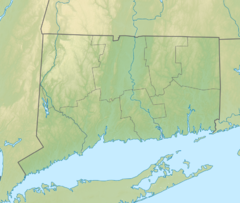Greens Ledge Light

The light in a 1907 postcard
|
|
|
Connecticut
|
|
| Location |
Norwalk Connecticut United States |
|---|---|
| Coordinates | 41°2′30″N 73°26′38.2″W / 41.04167°N 73.443944°WCoordinates: 41°2′30″N 73°26′38.2″W / 41.04167°N 73.443944°W |
| Year first constructed | 1902 |
| Foundation | cast iron with concrete caisson |
| Construction | Sparkplug lighthouse |
| Tower shape | 2-stages cylindrical tower with double balcony and lantern incorporating keeper's quarter |
| Markings / pattern | white upper half, brown on black lower half, black basement |
| Height | 52 feet (16 m) |
| Focal height | 62 feet (19 m) |
| Original lens | 5th order Fresnel lens (replaced with a 4th order) |
| Current lens | VRB-25 |
| Light source | solar power |
| Range | white: 18 nautical miles (33 km; 21 mi) red: 15 nautical miles (28 km; 17 mi) |
| Characteristic | Al WR 12s. |
| Fog signal | 2 blasts every 20s. |
| Admiralty number | J0866 |
| ARLHS number | USA-355 |
| USCG number |
1-21340 |
|
Greens Ledge Lighthouse
|
|
| Nearest city | Rowayton, Connecticut |
| Area | less than one acre |
| Architect | Philadelphia Construction Co. |
| MPS | Operating Lighthouses in Connecticut MPS |
| NRHP Reference # | |
| Added to NRHP | May 29, 1990 |
| Heritage | place listed on the National Register of Historic Places |
|
[]
|
|
1-21340
Greens Ledge Lighthouse is a sparkplug lighthouse in Connecticut, United States, off the southwest end of the Norwalk Islands, Long Island Sound, near Norwalk, Connecticut. It is on north side of the west end of Greens Ledge, west of Norwalk Harbor a mile south of the entrance to Five Mile River at Rowayton, and just over a mile southwest of Sheffield Lighthouse. Completed in 1902, it was constructed by the Philadelphia Construction Company. The light is 52 feet (16 m) tall and is made of five courses that make up its four stories. The lantern measures 7 feet (2.1 m) in diameter. The Greens Ledge Light replaced the Sheffield Island Light. Originally, the light had a fifth-order Fresnel lens, but a fourth-order Fresnel lens was installed in May 1902, just three months into its operation. Currently a VRB-25 is in use and it has alternating white and red flash every 24 seconds. The light was added to the National Register of Historic Places as Greens Ledge Lighthouse on May 29, 1990.
In 2017, a restoration campaign, 'Save Greens Ledge' was launched to preserve and protect Greens Ledge Light. Through the National Historic Lighthouse Preservation Act program, Greens Ledge was acquired by lifelong Connecticut residents Tim Pettee and the Pettee Family, who donated the lighthouse to the Greens Ledge Light Preservation Society, a newly-founded nonprofit, to spearhead the preservation effort. The Greens Ledge Light Preservation Society, colloquially known as the 'Keepers of Greens Ledge,' have a stated mission to "Save Greens Ledge and protect this historic icon of maritime Connecticut for generations to come."
In the 1890s, the lighthouse was first formally proposed to mark the Norwalk Harbor. In 1899, the United States Congress appropriated $60,000 for the establishment of a light and fog signal at Greens Ledge. In 1900, the Philadelphia Construction Company was contracted to construct the foundation and the superstructure. The design for this type of lighthouse was first realized in 1873, from Major Eliiot of the Lighthouse Board. The foundation form is made of identical curved-iron plates with top inward-pointing flanges that are bolted together and secured with knees. The assembled rings are lowered into the water and filled with concrete or stone, concrete for the Greens Ledge Light. A series of photographs from the work in 1901 shows the assembly of the three lower courses at Wilson's Point, the lowering of the cylinder and the light in the fall of 1901 prior to a deposit of protective riprap.
...
Wikipedia

